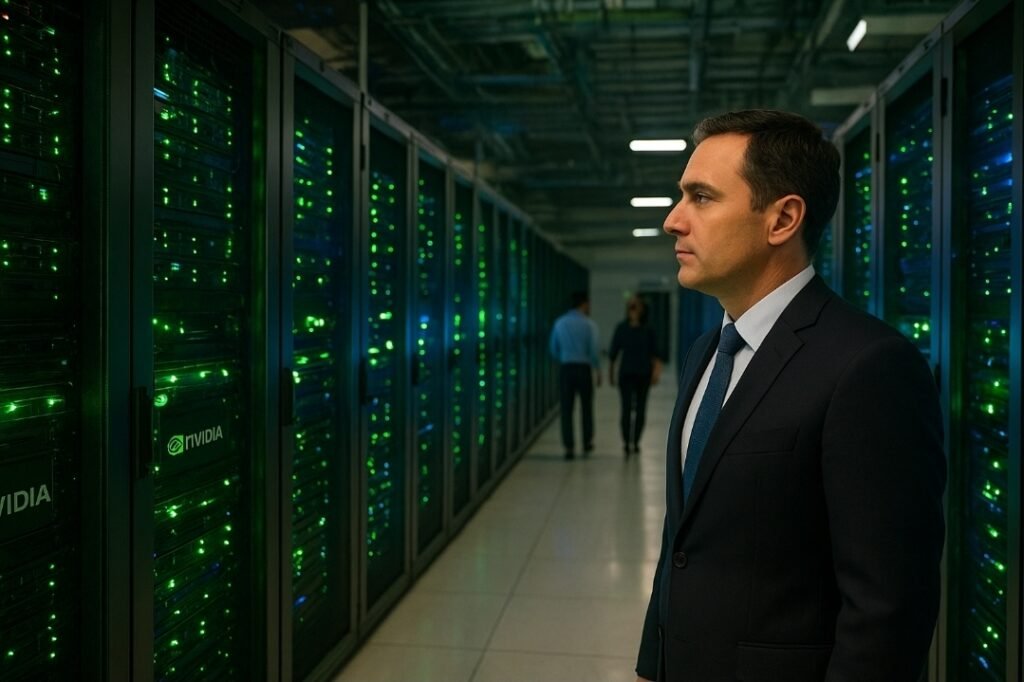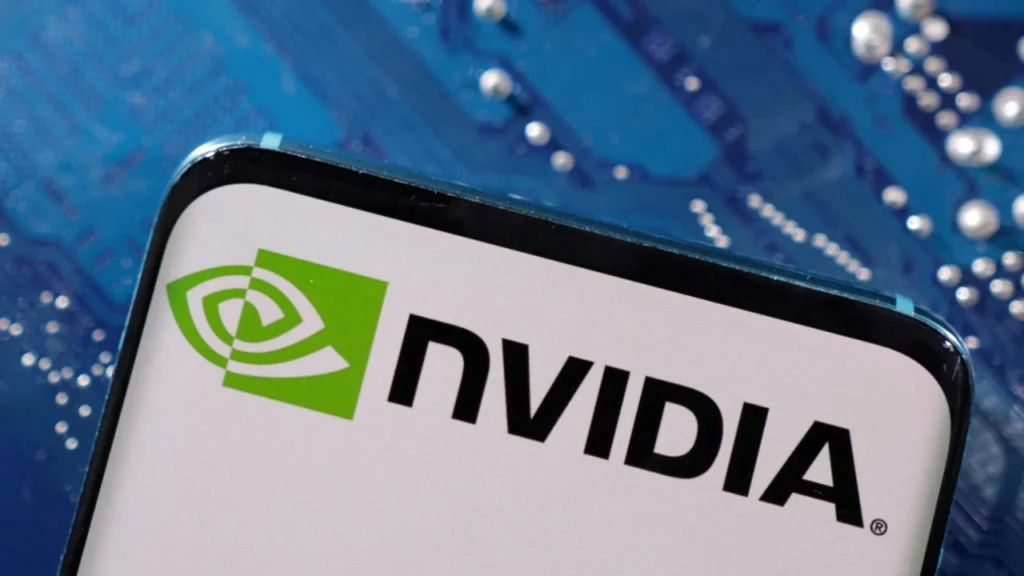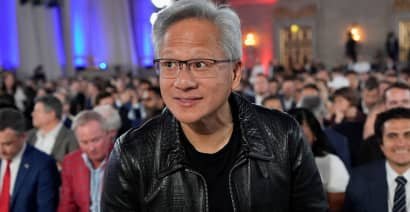In a reported deal worth over US$900 million, Nvidia has allegedly procured both the leadership and core interconnect technology of Enfabrica — a move many industry watchers see as strategic in the race to scale generative artificial intelligence (AI) workloads. The acquisition, which includes licence rights to Enfabrica’s chip technology, comes at a time when demand for high-capacity, efficient GPU clusters is exploding globally.
According to sources including CNBC and The Information, Nvidia has not only brought onboard Enfabrica’s CEO and several of its senior engineers, but has also secured licences to critical intellectual property owned by the startup. The technology in question centres on interconnect systems and memory fabric innovations that help data move faster within massive compute clusters.

Table of Contents
What Exactly Nvidia Acquired — And Why It Matters
Enfabrica has been developing systems aimed at solving longstanding bottlenecks in data centre GPU clusters. Two technologies are especially critical:
- SuperNIC and Accelerated Compute Fabric-SuperNIC (ACF-S): This is Enfabrica’s interconnect silicon. In contrast to traditional GPU setups with point-to-point links, ACF-S introduces multi-path architecture, which improves bandwidth, reduces latency, and enhances fault tolerance. Where a link might fail, the architecture ensures that compute jobs can continue without getting stalled.
- Elastic Memory Fabric System (EMFASYS): Available since July, this system allows AI servers to access memory bandwidth and capacity flexibly via standard network ports. It’s designed to boost memory utilisation without the need for expensive high-bandwidth memory modules in every component.
By acquiring the CEO and key staff, plus licensing these core technologies, Nvidia gains not just hardware IP but expertise and human capital. Analysts believe the move will help Nvidia build more unified and efficient GPU clusters — systems that can handle frontier models without excessive latency, cost or complexity.

Broader Trend: Acqui-hire + Licensing, Less Full Acquisitions
This may look like an acquisition, but what’s happening here resembles what some in the tech industry call an “acqui-hire plus licensing” approach. Instead of buying every asset and folding the company wholesale, Nvidia is integrating what it needs: leadership, talent, and the specific IP that adds immediate value.
In recent years, several big tech firms have adopted similar strategies:
- Meta’s engagement with Scale AI founder and team via investment and partial stake, rather than full buy-out.
- Google is bringing in Windsurf’s team and tools for its Gemini AI platform via licensing.
- Deals by Microsoft, Amazon, and others with startups in AI and research fields, where talent and narrow technology are more important than full organisational takeovers.
This method helps companies move faster, avoid overlapping product lines, and reduce regulatory friction. As Everest Group senior analyst Rachita Rao notes, absorbing Enfabrica’s technology and people may allow Nvidia to sidestep some of the integration challenges and regulatory baggage that traditional acquisitions bring.
At the same time, analysts warn that regulators are getting sharper in spotting these arrangements. Even when a company doesn’t formally acquire another in its entirety, bringing in IP, leadership, and core functions under one roof can draw scrutiny.
Implications for AI, Cost, and Competition
The combination of Enfabrica’s ACF-S and EMFASYS technologies with Nvidia’s existing hardware and software stack promises several immediate advantages for high-performance computing (HPC) and AI model training:
- Higher GPU Utilisation Rates
By improving how memory bandwidth and network interconnects are used, Nvidia should be able to reduce idle periods inside clusters. This means more work done per unit of hardware. - Lower Total Cost of Ownership (TCO)
Using a system like EMFASYS to allow flexible memory access over standard network ports could reduce reliance on expensive, dedicated high-bandwidth memory everywhere. That will likely cut hardware costs, energy use, cooling needs, and maintenance. - Improved Robustness and Fault Tolerance
With SuperNIC’s multipath architecture, failures in individual GPU links will have less effect on overall cluster performance. AI workloads that take days or weeks to train are especially vulnerable to disruptions; this mitigates those risks. Network World - Strategic Edge in the AI Arms Race
As other major players like Microsoft, Google, and Amazon push to scale frontier models, efficiency and scalability become battlefields. Nvidia’s move may give it more breathing room and capability to lead in training large AI systems, especially as costs and energy demands grow.
What Remains Unclear — And What to Watch Next
Despite the magnitude of the deal, many details are still unverified or evolving. Some things to keep an eye on:
- Full terms of the licence: Exactly how much of Enfabrica’s IP rights Nvidia now has, whether exclusively or not, and what obligations come with them.
- Personnel integration: How many of Enfabrica’s engineers and leaders remain, and how smoothly they’ll integrate into Nvidia’s teams. Culture, process, and vision alignment often determine whether such deals succeed long-term.
- Regulatory review: Will this deal face scrutiny in the US, EU or elsewhere, particularly under antitrust or competition law frameworks? Regulatory bodies have lately been more alert to such talent + IP-forward deals.
- Performance in practice: Can Nvidia achieve the promised reductions in cost, latency, and inefficiencies when these technologies are deployed at scale? It’s one thing to have a promising architecture on paper; it’s another to deliver reliably under global AI workload pressures.

Conclusion
For Nigeria and other African countries watching the AI and HPC arena, Nvidia’s reported acquisition of Enfabrica’s CEO, staff, and licences marks another rung in the ladder toward more efficient, powerful AI infrastructure. As companies globally chase next-generation models that demand more compute, memory, and network performance, deals like this set benchmarks for what’s coming.
The focus now will be on execution: how Nvidia integrates, deploys and delivers. If successful, this could accelerate AI development, lower training costs, and perhaps even influence how cloud providers and data centres in Africa architect their systems. But only time will tell whether this will be a transformative deal or simply another signal of how expensive and competitive AI infrastructure has become.
Join Our Social Media Channels:
WhatsApp: NaijaEyes
Facebook: NaijaEyes
Twitter: NaijaEyes
Instagram: NaijaEyes
TikTok: NaijaEyes
READ THE LATEST EDUCATION NEWS




